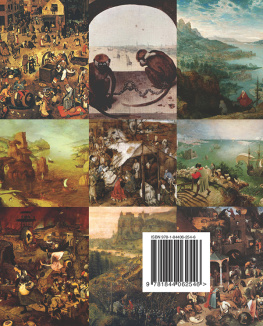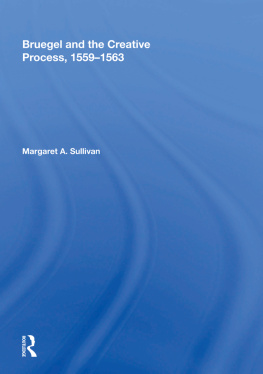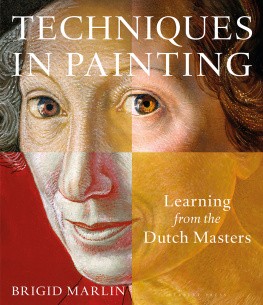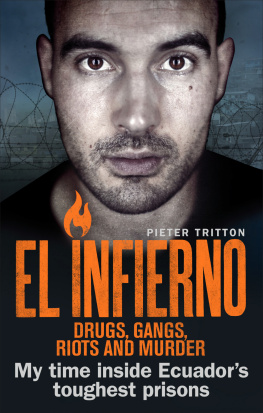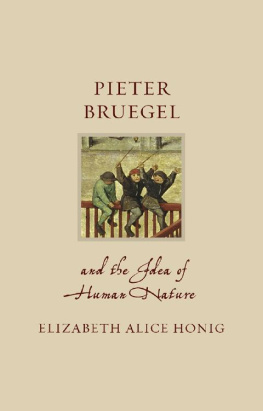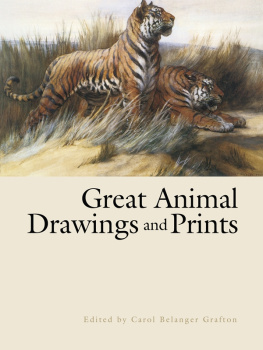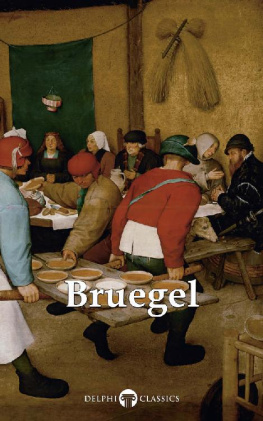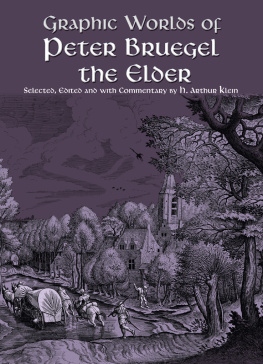Bruegel Pieter - Peter Bruegel: the elder
Here you can read online Bruegel Pieter - Peter Bruegel: the elder full text of the book (entire story) in english for free. Download pdf and epub, get meaning, cover and reviews about this ebook. City: Charlotte;North Carolina, year: 2014, publisher: Casemate Publishers & Book Distributors, LLC;TAJ Books International, genre: Detective and thriller. Description of the work, (preface) as well as reviews are available. Best literature library LitArk.com created for fans of good reading and offers a wide selection of genres:
Romance novel
Science fiction
Adventure
Detective
Science
History
Home and family
Prose
Art
Politics
Computer
Non-fiction
Religion
Business
Children
Humor
Choose a favorite category and find really read worthwhile books. Enjoy immersion in the world of imagination, feel the emotions of the characters or learn something new for yourself, make an fascinating discovery.
- Book:Peter Bruegel: the elder
- Author:
- Publisher:Casemate Publishers & Book Distributors, LLC;TAJ Books International
- Genre:
- Year:2014
- City:Charlotte;North Carolina
- Rating:5 / 5
- Favourites:Add to favourites
- Your mark:
- 100
- 1
- 2
- 3
- 4
- 5
Peter Bruegel: the elder: summary, description and annotation
We offer to read an annotation, description, summary or preface (depends on what the author of the book "Peter Bruegel: the elder" wrote himself). If you haven't found the necessary information about the book — write in the comments, we will try to find it.
Peter Bruegel: the elder — read online for free the complete book (whole text) full work
Below is the text of the book, divided by pages. System saving the place of the last page read, allows you to conveniently read the book "Peter Bruegel: the elder" online for free, without having to search again every time where you left off. Put a bookmark, and you can go to the page where you finished reading at any time.
Font size:
Interval:
Bookmark:

T he Flemish artist Pieter Bruegelsometimes called Peasant Bruegelwas the first great artist to paint scenes of ordinary peasant life and show the common man and woman as they went about their daily tasks and amusements. He is credited with bringing a humanizing spirit to paintingsomething that was lacking in medieval works and entirely absent from contemporary Renaissance paintings. His compositions are full of rich details and reward close examination; in fact, they are used by cultural historians as source material for old Flemish customs, styles of dress, cultivation, and many other aspects of 16th-century everyday life.
In 1563 Bruegel painted one of his most famous works, The Tower of Babel, for the first time; during his lifetime, he painted the subject three times. Called a figurative allegory, The Tower of Babel tells a story from the Old Testament, Genesis 11:19. The theme is the futility of human ambition and commercial greed. Other subjects, many produced as prints, included the seven deadly sins (or vices) and the seven virtues.
At his death in 1569, his old friend Ortelius described him as the most perfect painter of his time. His two sons Pieter and Jan, also accomplished artists, followed in their fathers footsteps, firmly establishing the Brueg(h)el name in the art history books.
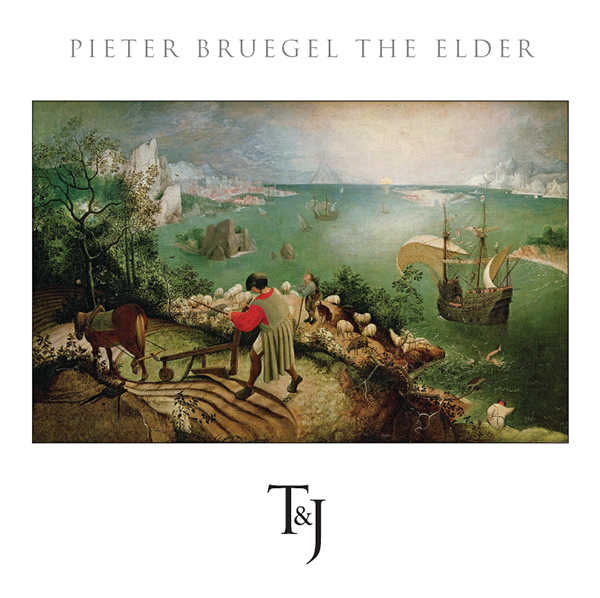
Published by TAJ Books International LLC 2014
5501 Kincross Lane
Charlotte, North Carolina, USA
28277
www.tajbooks.com
www.tajminibooks.com
Copyright 2014 TAJ Books International LLC
All rights reserved. No part of this publication may be reproduced, stored in a retrieval system, or transmitted in any form or by any means, electronic, mechanical, photocopying, recording, or otherwise, without the prior written permission of the Publisher and copyright holders.
All notations of errors or omissions (author inquiries, permissions) concerning the content of this book should be addressed to .
ISBN 978-1-84406-254-6
Printed in China
1 2 3 4 5 18 17 16 15 14
c. 1525-1569
T he Flemish artist Pieter Bruegel sometimes called Peasant Bruegel, and usually distinguished from the other painters in his family as Pieter Bruegel the Elder was one of the greatest painters of the late medieval/early Renaissance period, whose The Hunters in the Snow and The Peasant Wedding are as accessible to a modern audience as they were some 500 years ago when he painted them.
Bruegel was the first great artist to paint scenes of ordinary peasant life and show the common man and woman as they went about their daily tasks and amusements. He is credited with bringing a humanizing spirit to paintingsomething that was lacking in medieval works and entirely absent from contemporary Renaissance paintings. His compositions are full of rich details and reward close examination; in fact, they are used by cultural historians as source material for old Flemish customs, styles of dress, cultivation, and many other aspects of sixteenth-century everyday life.
Pieter Bruegel the Elder was the father of three further generations of artists, most notably his sonsPieter Brueghel the Younger and Jan Brueghel the Elderand his grandson, Jan Brueghel the Younger, son of Jan Brueghel the Elder. There were other artists in the family, not least of which was Bruegels mother-in-law, Mayken Verhulst, a noted watercolorist who was acclaimed as one of the four best female artists of the time.
Pieter Bruegel the Elder spent his working life in Antwerp and Brussels in what was called the Low Countries, now Belgium and the Netherlands. Both cities were important trading ports and economic centers, and Antwerp was the main center of publishing in the Netherlands. The period in which he lived, the mid-1500s, was a turbulent time in history when the Low Countries were occupied by the Catholic Spanish Hapsburgs. Bruegel was born a few years after Martin Luther launched the Protestant Revolution, which initiated much agitation between the Roman Catholic Church and the Protestant Church. Bruegel, who for the period in which he lived made relatively few religious paintings, was not obviously religious.
When Bruegel began to paint, Italian Mannerism was the prevailing style. Initially, however, Bruegel deliberately reverted to the traditional late-Gothic style as exemplified by the Dutch artist Hieronymus Bosch, who although he had died in 1516 was still fashionable and popular in the Low Countries. For a period, Bruegel was even known as the second Bosch.
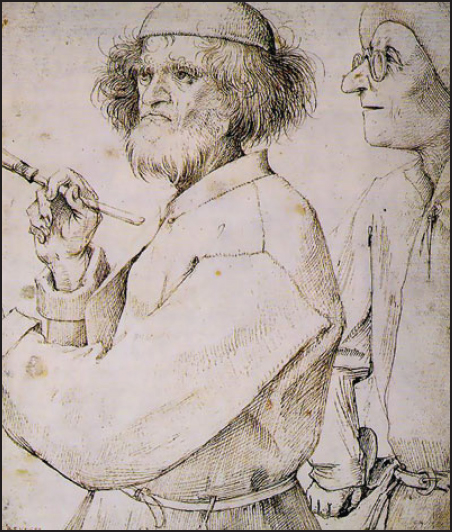
Believed to be a self-portrait, c. 1565
Unfortunately, little detail is known about Bruegels life. The odd legal paper dates him to time and place, and his later paintings are very usefully dated, but much of the personal detail about him has to be inferred. He followed a profession that most considered skilled but artisanal, and therefore unworthy of special attention. He appears to have been something of an intellectual and was a noted humanist, who counted many scholars among his friends, but he did not leave any writings that could have thrown light on his thoughts.
The influence of Hieronymous Bosch and elements of his style persist in Bruegels compositions until around the early 1560s. Bruegel did bring Boschs hellish themes up to date by incorporating modern landscapes into the backgrounds as well as contemporary costumes combined with an altogether brighter palette using more structured and refined composition. His early works, although not overtly religious, worked the themes of good and evil, foolish and sinful, usually represented in allegorical form. With maturity, his paintings became more confidently contemporary and secular, showing eloquent commentaries on Flemish peasant life. On close inspection his paintings always carry a moral, and he uses symbols such as peacock feathers to convey vanity.
Bruegel was one of an elite group of intellectuals who pioneered humanist ideas in the Low Countries during the mid-sixteenth century and counted among his friends and patrons many of the leading intellectual lights of the age, including the scholar and cartographer Abraham Ortelius and the important Antwerp printer Christoph Plan tin. During his lifetime Bruegel had two principal patrons, the rich Antwerp merchant Nicolaas Jonghelinck and Cardinal Granvelle, although the latter is only known to have owned Landscape with the Flight into Egypt. His friend Ortelius also possessed a number of his works, but only his ownership of the grisaille (oil) titled The Dormition of the Virgin is known for certain.
In the light of the hostile Spanish occupation of the Low Countries, Bruegel had to be very careful not to openly criticize Spain for fear of emphatic retribution, so he hid his opinions within his paintings for viewers to interpret. For example, his Massacre of the Innocents, painted about 1566, was an apparently religious piece, but it was actually a criticism of the cruelties and atrocities of the Spanish Inquisition across the Low Countries, as evidenced by the contemporary Flemish village setting.
Bruegel was not interested in painting portraits of the rich and famous, or nudes, or classical scenes from antiquity. Instead, he was interested in everyday peasant life, in how ordinary people worked and passed their leisure time. He is credited with humanizing traditional subjects and personalizing them in a way that had not been attempted before. His only interest in landscapes was as a background for his peasant scenes. These scenes were not idealized, but were composed of people with realistic, coarse faces and dumpy, workmanlike figures. Bruegel was not a peasant himself, but he obviously enjoyed mixing with peasants and learning their routines and lifestyles and was the first painter to depict ordinary peasant life without sentimentalizing or sensationalizing it.
Font size:
Interval:
Bookmark:
Similar books «Peter Bruegel: the elder»
Look at similar books to Peter Bruegel: the elder. We have selected literature similar in name and meaning in the hope of providing readers with more options to find new, interesting, not yet read works.
Discussion, reviews of the book Peter Bruegel: the elder and just readers' own opinions. Leave your comments, write what you think about the work, its meaning or the main characters. Specify what exactly you liked and what you didn't like, and why you think so.

